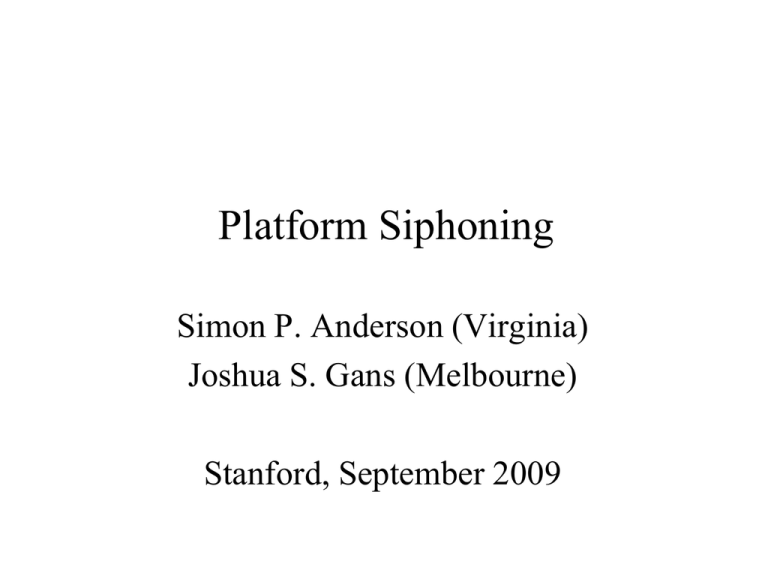TiVoed: The Effects of Ad-Avoidance Technologies on Broadcaster
advertisement

Platform Siphoning Simon P. Anderson (Virginia) Joshua S. Gans (Melbourne) Stanford, September 2009 Ad-Avoidance Technologies Ad-Avoidance Technologies Ad-Avoidance Technologies Reactions to Ad-Avoidance “The future of the TV business is dependent on enabling advertisers to reach people who don't want to watch ads and who have the ability to avoid them. You can see this issue coming a mile away and marketers and networks should be prepared.” (Tom Rogers, CEO TiVo, 2009) “It’s obvious how rampant ad blocking hurts the Web: If every passenger siphons off a bit of fuel from the tank before the plane takes off, it’s going to crash.” (Farhad Manjoo, Slate, 2009) “Because of the ad skips.... It’s theft. Your contract with the network when you get the show is you’re going to watch the spots. Otherwise you couldn’t get the show on an ad-supported basis. Any time you skip a commercial or watch the button you’re actually stealing the programming.” (James Kellner, CEO Turner Broadcasting, 2002) Types of Ad-Avoidance • Do consumers like ads? – Information view: will pay to buy ads (e.g., trade mags) – Nuisance view: will pay to avoid ads (e.g., television) • Traditional ad-avoidance – Going to the bathroom – Not paying attention • Ad-avoidance technologies – – – – – VCRs DVRs (e.g., Tivo) Download TV (e.g., iTunes) and DVDs Pop-up Blockers Ad-blockers Substitution from Ads Ad-avoidance is a threat to the traditional twosided model of selling content … it unbundles the product. Will it cause a ‘death spiral’? • Conventional wisdom – In order to compete for viewers, broadcasters will have to reduce advertising levels – But, contrast this with continual rise in advertising levels on television Research Question How will content providers respond to AAT penetration? • Informal response: – will move to reduce the ‘cost’ to consumers so as to limit incentives to adopt AATs; decrease clutter – will try and target niche audiences to tailor more effective advertising • Our formal result: – AAT penetration means that the marginal viewer has lower ad disutility so content providers will increase clutter – will try and broaden the appeal of content Literature • Anderson and Coate (2005) – How broadcasters compete and whether prices improve welfare? • Wilbur (2005) – Demonstrates that rising AAT penetration as been associated with increases in advertising ‘clutter.’ Outline 1. Model & Set-Up 2. AATs as durable goods 3. Extensions – Content – Competition – Pay television 4. Versus traditional ad avoidance 5. Conclusion Notation and Set-Up • Content provider – Monopolist – No marginal costs • Viewers – Located in (x, g) space: Uniform on [0, x ] [0, g ] – Utility: U x ,g (1 x) g a • Advertisers – Price per viewer: r(a); various concavity assumptions – Revenue per viewer: R(a) = r(a)a Equilibrium without AATs • Choose a to maximise R(a)N g a (a) N (a) 1 R a a R Na a N • Anderson-Coate condition • When r is (-1) concave (weaker than concavity), the equilibrium is unique. Viewers ()/ x Technical Issue • Why don’t we get? • At this point, N FTA ( ) 2 ag x N (a) Na 2 a N g ()/a 1 • A percent increase in advertising decreases viewership by one percent • But increases revenue by less than one percent • So it is more profitable to decrease advertising. Viewers ()/ x Traditional Ad-Avoidance • At a cost of c, consumers can avoid ads after the provider has committed an ad level, a. • Will do so if ga > c • Result: For sufficiently low c, providers set ad levels to deter consumers from ad-avoidance. • As c falls, equilibrium a falls. w/o avoidance (+-p)/ g aˆ p / g p / aˆ Viewers (+)/ x Modeling AATs • Durable good (timeline) 1. Consumers purchase AATs – fixed price, p 2. Broadcasters observe AAT penetration 3. Broadcasters choose advertising level (Technical issue: look for rational expectations equilibrium) Non-equilibrium Outcomes a aˆ a aˆ g g AAT Viewers AAT Viewers p / aˆ p / aˆ Viewers (+-p)/ Viewers (+)/ x (+-p)/ (+)/ â = Advertising level anticipated by consumers x Equilibrium with AAT a(gˆ) aˆ • Proposition 3: For a given p, ( x, g ) g p / aˆ ( p) and x p purchase an AAT • The equilibrium is unique with: a (aˆ ( p)) p 2( ) p g AAT Viewers gˆ p / aˆ p / aˆ Viewers (+-p)/ (+)/ x Impact on Advertising • Proposition 4: A lower AAT price increases equilibrium advertising. a (aˆ ) Decreasing in a p 2( ) p Increasing in p High disutility viewers purchase AATs so the marginal one has lower disutility. Hence, profit maximising to increase their ‘price.’ Impact on Advertising • Lower p makes viewership less advertising elastic • Worthwhile to increase level of advertising (lose fewer viewers) a(gˆ) aˆ g AAT Viewers gˆ p / aˆ p / aˆ Viewers (+-p)/ (+)/ x Network Effects • As increase AAT penetration – Providers increase advertising clutter – Marginal consumers purchase AATs • AAT purchases governed by a positive network effect • Association of increased AAT penetration and increased clutter may be causal • Demand for AATs more elastic than an ordinary good due to the negative externality imposed on nonpurchasers Impact on Welfare • Decreased welfare – low disutility viewers; including some who purchase AATs – Provider • Increased welfare – High disutility viewers; increased viewership – Advertisers? When there is low quality and mild AAT penetration Viewers watch TV g AAT Viewers (>) Without AAT AAT Viewers (<) gˆ p / aˆ Viewers stop watching TV p / aˆ With AAT Non AAT Viewers (<) (+-p)/ (+)/ x Welfare Impact • Providers – Increased AAT penetration decreases profits – Possible death spiral if providers have fixed costs – But in rational expectations equilibrium, marginal consumer will not purchase an AAT; just enough to keep the provider in business. • Advertisers – Reduced viewership but provider increases advertising space and reduces rates – Proposition 6: with low quality (so viewer loss is small), increased AAT penetration can increase advertiser welfare. Endogenous Content • Timeline: 1. Consumers choose whether to purchase AAT or not for price, p 2. Broadcaster chooses or (some cost) 3. Broadcaster observe AAT penetration 4. Broadcaster chooses advertising space “Time-shifted” content Top Rated Shows Top “Time-shifted” Shows 1 AMERICAN IDOL-TUESDAY 2 AMERICAN IDOL-WEDNESDAY 3 DANCING WITH THE STARS 4 CSI 5 DANCING W/STARS RESULTS 6 NBC SUNDAY NIGHT FOOTBALL 7 CSI: MIAMI 8 DESPERATE HOUSEWIVES 9 HOUSE 10 DEAL OR NO DEAL-MON 10 WITHOUT A TRACE Source: Nielsen Media Research 1 STUDIO 60 2 HEROES 3 GILMORE GIRLS 4 AMERICA’S NEXT TOP MODEL 5 30 ROCK 5 FRIDAY NIGHT LIGHTS 7 NINE, THE 7 SUPERNATURAL 9 KIDNAPPED 9 ONE TREE HILL 9 SMALLVILLE Source: Nielsen Media Research Content Quality Increased Increased g g Viewers Viewers ()/ x ()/ x Vertical Quality () • Impact on advertising – Higher vertical quality increases the broadcaster’s choice of a as viewership is less sensitive to increases in a. g AAT Viewers • Impact of p (AAT affordability) – Decrease and preserve advertising levels and rates • But anticipated quality reduction will check AAT growth Viewers ()/ x Horizontal Quality () • Impact on advertising – Lower implies ‘flatter’ demand – switch to programming with more mass market appeal – profits convex in (Johnson-Myatt, AER, 2006) – Higher (more niche programming) increases the broadcaster’s choice of a as viewership is less sensitive to increases in a. • g AAT Viewers Impact of p (AAT affordability) – Decrease as do not care about high disutility/TV loving viewers (they have AATs) any more – So increase advertising even further – Less targeted viewership Viewers Viewers ()/ x Broadcaster Competition • Suppose there are two broadcasters: one located at x = 0 and the other at x = x . • Symmetric equilibrium g 0’s Viewers p a (aˆ ) 2x 1’s Viewers x Paying for Content • Suppose that viewers are charged a subscription fee, s, as well as seeing advertising content. • The provider faces a trade-off between s and a. • Expected case: large AAT penetration, s rises and a falls • Interesting case: small AAT penetration, s falls and a rises • From free, may not increase profits to charge relative to increase advertising levels. g AAT Viewers Viewers Viewers ()/ x Conclusions • Case of emerging substitutes on one side of a two sided market. • Reaction to the substitute can be to accommodate rather than deter it. • Suggests that two-sided markets cannot viewed in isolation of a broader strategic context. Future Directions • Extensions – Multiple distribution channels (broadcast and download/DVDs) – Dynamic effects: addictive television • Bigger Questions – Why don’t we pay consumers directly to watch ads? • Welfare opportunity versus bundling/lemons effects – Accounting for concentration of advertising in media forms • Magazines versus books



